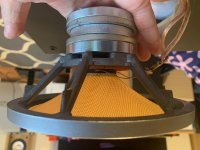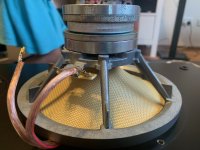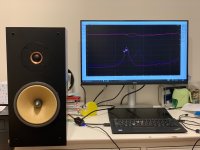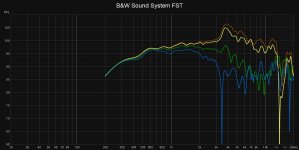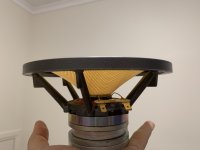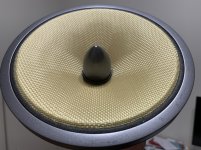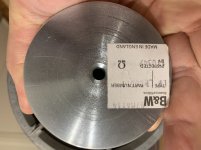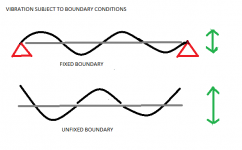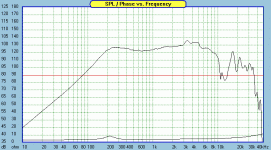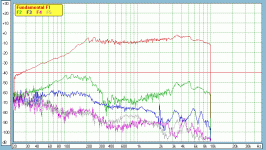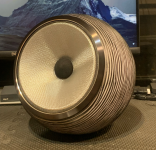Once in awhile, a product that causes a revelation: some companies really did have outstanding engineering!
This is one of the twelve 6" midranges used in the B&W Sound System for the 2014 Primavera Sound festival (ESP)

Project engineer and system designer was our very own @truecolour
Various reports by
Pocket Lint
AudioXpress
Igloo Dome
What Hi-Fi
This thread is a measurement/review of the custom 6” drive unit from the system. A few of us were fortunate to acquire this unicorn.
Background- the midrange unit is based on a midrange unit from the CT8LR custom-install system:

The main difference between this and the CT8 driver is that this has a yellow cone, but the similarities include a twin neo magnet, allegedly for symmetric BL(x) and Le(x).
Like the 800 series midranges, it uses the woven Kevlar cone, and dispenses with the traditional surround, instead having a thin foam “Fixed Suspension”. This surround (and spider) affords the cone only a few mm of movement, BUT perhaps because of this, reduces surround radiation distortion
So low, In fact, that the microphone was not able to accurately measure the harmonics:
Sonarworks Xref20 mic:

Incredibly, it has the sensitivity of pro-sound midranges- ie. >95dB/2.83V/1m, yet displays a smooth and extended frequency response to past 10KHz, and mild breakups only occurring past 3KHz.
B&W measurement of individual drivers in CT8 cabinet (blue trace)

When this first arrived to me in Australia, I plopped this driver into an existing test box and took some measurements, including on axis, 15, 30 and 45 degrees off axis.
The sine sweep had a gate of of 5ms (measurements good down to 200Hz) and since it is an 4 ohm nominal driver, I tested with only 2V drive at 1m.
The baffle is 8 1/4” wide; with no roundovers for edge diffraction control- this contributes at least 2dB to the peaking at 4KHz. Also the driver is surface mounted, which causes raggedness of at least +/-1dB anywhere above 2Khz. So this quick/dirty measurement on an unoptimised baffle.
Just add 3dB to figure out the 2.83V sensitivity- that’s almost 100dB /2.83V
Now, to find woofers and tweeters that can keep up!
Edit: One of the Sound System’s tweeter is measured is post #37
Edit 2: April 2025- less fiction
This is one of the twelve 6" midranges used in the B&W Sound System for the 2014 Primavera Sound festival (ESP)
Project engineer and system designer was our very own @truecolour
Various reports by
Pocket Lint
AudioXpress
Igloo Dome
What Hi-Fi
This thread is a measurement/review of the custom 6” drive unit from the system. A few of us were fortunate to acquire this unicorn.
Background- the midrange unit is based on a midrange unit from the CT8LR custom-install system:
The main difference between this and the CT8 driver is that this has a yellow cone, but the similarities include a twin neo magnet, allegedly for symmetric BL(x) and Le(x).
Like the 800 series midranges, it uses the woven Kevlar cone, and dispenses with the traditional surround, instead having a thin foam “Fixed Suspension”. This surround (and spider) affords the cone only a few mm of movement, BUT perhaps because of this, reduces surround radiation distortion
So low, In fact, that the microphone was not able to accurately measure the harmonics:
Sonarworks Xref20 mic:
Incredibly, it has the sensitivity of pro-sound midranges- ie. >95dB/2.83V/1m, yet displays a smooth and extended frequency response to past 10KHz, and mild breakups only occurring past 3KHz.
B&W measurement of individual drivers in CT8 cabinet (blue trace)
When this first arrived to me in Australia, I plopped this driver into an existing test box and took some measurements, including on axis, 15, 30 and 45 degrees off axis.
The sine sweep had a gate of of 5ms (measurements good down to 200Hz) and since it is an 4 ohm nominal driver, I tested with only 2V drive at 1m.
The baffle is 8 1/4” wide; with no roundovers for edge diffraction control- this contributes at least 2dB to the peaking at 4KHz. Also the driver is surface mounted, which causes raggedness of at least +/-1dB anywhere above 2Khz. So this quick/dirty measurement on an unoptimised baffle.
Just add 3dB to figure out the 2.83V sensitivity- that’s almost 100dB /2.83V
Now, to find woofers and tweeters that can keep up!
Edit: One of the Sound System’s tweeter is measured is post #37
Edit 2: April 2025- less fiction
Attachments
Last edited:
Any decent compression driver will do more than just keep up. It is usual that compression driver in relatively small waveguide does 107dB/2.83V. 2x15" on the bottom can take care of bass duty.
Beyond that, i really like B&W kevlar midranges since Zaph measured the first one, and that was long time ago. Their tweeters are crazy good also - with the right crossover though.
Beyond that, i really like B&W kevlar midranges since Zaph measured the first one, and that was long time ago. Their tweeters are crazy good also - with the right crossover though.
Last edited:
Looks ok up to about 3kHz then you start seeing some oddities, first there is a 5db peak at ~3,8kHz that needs some attention even if crossed around 2-2,5kHz, and above that it stays abit bumpy, impressive sensititivity though, considering its size.
I like the lack of compression driver for midrange duties. I will use a CD if its absolutely necessary for PA purposes, but good ones that actually sound accurate and clean playing loud cost a fortune. I do not like the CD "sound" under 4Khz, especially with smaller 1 inch drivers. You need a 2 inch driver to reproduce 1Khz+ loud and clean. The kevlar mids from B&W are top notch and likely some of the best available from any manufacturer.
The B&W metal domes are exceptional, but I think they're trying to use them for PA purposes to prove a point rather than implement a practical solution. Planar drivers sound better for that purpose and can be arrayed much easier with their limited vertical pattern. You'd have to be really clever to make a direct radiating HF dome array work well for a PA setup.
The use of MF and HF waveguides makes more sense to control directivity for better off axis linearity. Trying to control directivity without the use of waveguides is very difficult. The resulting loss of efficiency is a big factor.
The B&W metal domes are exceptional, but I think they're trying to use them for PA purposes to prove a point rather than implement a practical solution. Planar drivers sound better for that purpose and can be arrayed much easier with their limited vertical pattern. You'd have to be really clever to make a direct radiating HF dome array work well for a PA setup.
The use of MF and HF waveguides makes more sense to control directivity for better off axis linearity. Trying to control directivity without the use of waveguides is very difficult. The resulting loss of efficiency is a big factor.
Looks like total THD above 400 Hz of that mid is around -50dB, which is really good,
That notch just under 4k looks like a VC gap cavity resonance coupled with start of cone breakup right above that. Off axis looks manageable with tricky filtering. This isn't your typical DIY friendly driver. Impressive feit pushing the cone breakup on a driver this size that far out.
That notch just under 4k looks like a VC gap cavity resonance coupled with start of cone breakup right above that. Off axis looks manageable with tricky filtering. This isn't your typical DIY friendly driver. Impressive feit pushing the cone breakup on a driver this size that far out.
The distortion is excellent, particularly H3 and higher order H5 to H9.
Letting the drivers talk to me, I think the natural lower cutoff is around 400Hz. Maybe 300Hz LR4 depending on how loud I listen. At the upper end; I’d take it to 1.8Khz if I wanted to maximise the dispersion. But that mean it’s only covering 2.5 octaves.
B&W crossover designers for their passive crossovers seem to follow a “let this play as much as possible” and take it all the way to it 4KHz, even though their tweeter can handle a 2Khz crossover.
I probably need to build a spherical baffle like Matt Storey’s FSTNT1 and Curt Campbell’s Exclamations.
Does anyone know a way to model measurements on a spherical baffle?
Letting the drivers talk to me, I think the natural lower cutoff is around 400Hz. Maybe 300Hz LR4 depending on how loud I listen. At the upper end; I’d take it to 1.8Khz if I wanted to maximise the dispersion. But that mean it’s only covering 2.5 octaves.
B&W crossover designers for their passive crossovers seem to follow a “let this play as much as possible” and take it all the way to it 4KHz, even though their tweeter can handle a 2Khz crossover.
I probably need to build a spherical baffle like Matt Storey’s FSTNT1 and Curt Campbell’s Exclamations.
Does anyone know a way to model measurements on a spherical baffle?
Attachments
Last edited:
Before you get too carried away by B&W's engineering genius, we can be aware of the maths behind solutions to a differential equation with different surrounds and voicecoil drive...
Rigid surrounds and voltage drive tend to fix the boundaries into what is known as the Dirichlet boundary condition. Bit like a guitar string fixed at the fret and bridge. B&W solution or corrugated surrounds might get near this. Top image.
Unfixed surrounds and current drive will leave the ends or boundaries free to flap around. This is the Neumann boundary condition. Foam surrounds might get near this. Bottom image.
Many other factors involved. Cone profile, inherent damping of the cone. Damping at a rubber edge surround and voicecoil in intermediate conditions. Always hard to get right.
Nothing is perfect! Kevlar is generally considered overly lively and prone to nasty breakups around 4kHz here. Metal is worse, polycones better on breakup.
Because maths applies to most things, the images below might as well be the hypothetical strings in Physics either attached to a D-Brane or in free space. Or speakers! 😀
Baffle shape and size might be classed as a boundary condition too. Affects dispersion.
Rigid surrounds and voltage drive tend to fix the boundaries into what is known as the Dirichlet boundary condition. Bit like a guitar string fixed at the fret and bridge. B&W solution or corrugated surrounds might get near this. Top image.
Unfixed surrounds and current drive will leave the ends or boundaries free to flap around. This is the Neumann boundary condition. Foam surrounds might get near this. Bottom image.
Many other factors involved. Cone profile, inherent damping of the cone. Damping at a rubber edge surround and voicecoil in intermediate conditions. Always hard to get right.
Nothing is perfect! Kevlar is generally considered overly lively and prone to nasty breakups around 4kHz here. Metal is worse, polycones better on breakup.
Because maths applies to most things, the images below might as well be the hypothetical strings in Physics either attached to a D-Brane or in free space. Or speakers! 😀
Baffle shape and size might be classed as a boundary condition too. Affects dispersion.
Attachments
I agree with Zvu; Zaph measured this type of driver 10 years and 1 month ago and I remember wow- what a phenom of a midrange.
The woven Kevlar cone behaves closer to a soft cone than a hard cone, with very well managed breakups. And that higher order harmonic distortion was just sunk below the recesses:
This midrange just supercharges the sensitivity using a double neo magnet.
The woven Kevlar cone behaves closer to a soft cone than a hard cone, with very well managed breakups. And that higher order harmonic distortion was just sunk below the recesses:
This midrange just supercharges the sensitivity using a double neo magnet.
Attachments
Last edited:
Based on the information we have about the performance, technology, and construction, it is clear that this is an excellent midrange driver. It does not appear to be a huge leap forward in performance compared to other very high performance drivers.
If is comparable in performance, technology, and construction to ScanSpeak Illuminator series, Purifi, and Satori textreme drivers. In my opinion, if it were offered for sale in the DIY market, the competitive price would be in the $300 - $400 (USD) range.
If is comparable in performance, technology, and construction to ScanSpeak Illuminator series, Purifi, and Satori textreme drivers. In my opinion, if it were offered for sale in the DIY market, the competitive price would be in the $300 - $400 (USD) range.
Based on the information we have about the performance, technology, and construction, it is clear that this is an excellent midrange driver. It does not appear to be a huge leap forward in performance compared to other very high performance drivers.
If is comparable in performance, technology, and construction to ScanSpeak Illuminator series, Purifi, and Satori textreme drivers. In my opinion, if it were offered for sale in the DIY market, the competitive price would be in the $300 - $400 (USD) range.
Hello,
I agree, and the closest available product available to DIYers, I think, is the SB Audience
6” Nero midrange:
SB Audience :: NERO-6MRN150D
Sensitivity very high (98dB/2.83V; 8 ohm driver)
Benefits of soft cone- smooth FR with controlled breakups without high Q resonances
Flat foam surround with 1-2mm Xmax and
bandwidth about 400Hz to 2.5Khz judging by the distortion measurements; as
tested by Vance for Voice Coil recently.
The NERO-6MRN150D Midrange Woofer from SB Audience | audioXpress
Last edited:
Wow. Is that an enclosure from Ikea? CB or ported?
Now we have to figure out how to get a tweeter in place of the dust cap...
Now we have to figure out how to get a tweeter in place of the dust cap...
B&W tries to cash in on the trend of the dj soundsystem market for higher sound quality. The Despacio sound system from James Murphy & The Dewaele Brothers (To Many DJ's/Soulwax) showed that there is a market for those and Function One, Danley Labs and Void Acoustics already capitalise on that trend for long. But now B&W tries to set themselves above that in the ranking. They say the rig is not for sale, but that is a typical marketing trick to make it 'exclusive, so they can sell it for ridiculous prices...
I never heared the rig, but the last itterations of the B&W speakers don't sound good to me. It's tuned to bright and sounds harsh. But that mid driver is indeed a gem, and I would like that B&W tunes their speakers back like they did a few decades ago, when their fame was deserved. I hope this system has a better freuqency response than their actual hifi speakers. Their drivers are not really the problem i think, it's how the crossover is tuned. And it's not a lack of skills, it's making their speakers sound good in typical hifi shops so they sell.
I never heared the rig, but the last itterations of the B&W speakers don't sound good to me. It's tuned to bright and sounds harsh. But that mid driver is indeed a gem, and I would like that B&W tunes their speakers back like they did a few decades ago, when their fame was deserved. I hope this system has a better freuqency response than their actual hifi speakers. Their drivers are not really the problem i think, it's how the crossover is tuned. And it's not a lack of skills, it's making their speakers sound good in typical hifi shops so they sell.
Post COVID in 2023- the B&W Sound System rode again!
https://www.bowerswilkins.com/en-us...Os5YSIfhV3YdBpQo6GAVmo4LEkC3_QJLR23gBWg0C9oL4
History depends on who’s telling it:
As far back as 1993, Simon Ghajary and Lawrence Dickie were excavating walls and installing 801 drivers into nightclubs.
Here’s twenty four 801 bass drivers at The Great Escape, a nightclub in Brighton, England.
…this is before Twilo, Space.. before the fall of the Berlin wall, the Love Parade… or even “in-wall subwoofers” became “a thing”

Reference:
https://www.blueroomsounds.com/future-shape-of-sound
https://www.bowerswilkins.com/en-us...Os5YSIfhV3YdBpQo6GAVmo4LEkC3_QJLR23gBWg0C9oL4
History depends on who’s telling it:
As far back as 1993, Simon Ghajary and Lawrence Dickie were excavating walls and installing 801 drivers into nightclubs.
Here’s twenty four 801 bass drivers at The Great Escape, a nightclub in Brighton, England.
…this is before Twilo, Space.. before the fall of the Berlin wall, the Love Parade… or even “in-wall subwoofers” became “a thing”
Reference:
https://www.blueroomsounds.com/future-shape-of-sound
Last edited:
Our oldest (modern style) night clubs in Belgium, the Popcorn used Altec A7 speakers, and the other legandaric club in Belgium of the 1980's, the Boccacio had a JBL Cinema systems. The Fuse, the legendaric techno nightclub in Brussels, had in the early days also an Altec A7 system, but it was soon replaced as it could not keep up with the modern techno they played there....
This is the Boccacio in 1988, in the mids of the newbeat and EBM hype that ran around this club with the JBL rig. The club was running (under different names) until a few years ago and is now demolished to make place for a sport complex.

So running hifi or theater gear is not new at all, in the early days of nightclubs it happened all the time as those were often better than the pa gear of that time in sound quality. Nightclubs in Belgium in the 1970's and 1980's bought often old movie theater gear as it's fit for big closed spaces on high volume.
This is the Boccacio in 1988, in the mids of the newbeat and EBM hype that ran around this club with the JBL rig. The club was running (under different names) until a few years ago and is now demolished to make place for a sport complex.
So running hifi or theater gear is not new at all, in the early days of nightclubs it happened all the time as those were often better than the pa gear of that time in sound quality. Nightclubs in Belgium in the 1970's and 1980's bought often old movie theater gear as it's fit for big closed spaces on high volume.
Look up the posts from @5th element , on his FST project or his webpage, concerning the yellow kevlar cone FST.Now we have to figure out how to get a tweeter in place of the dust cap...
The b&w FST "phaseplugs" are fairly easy to remove.
No glued in place dustcap
- Home
- Loudspeakers
- Multi-Way
- B&W Engineering - incredible
